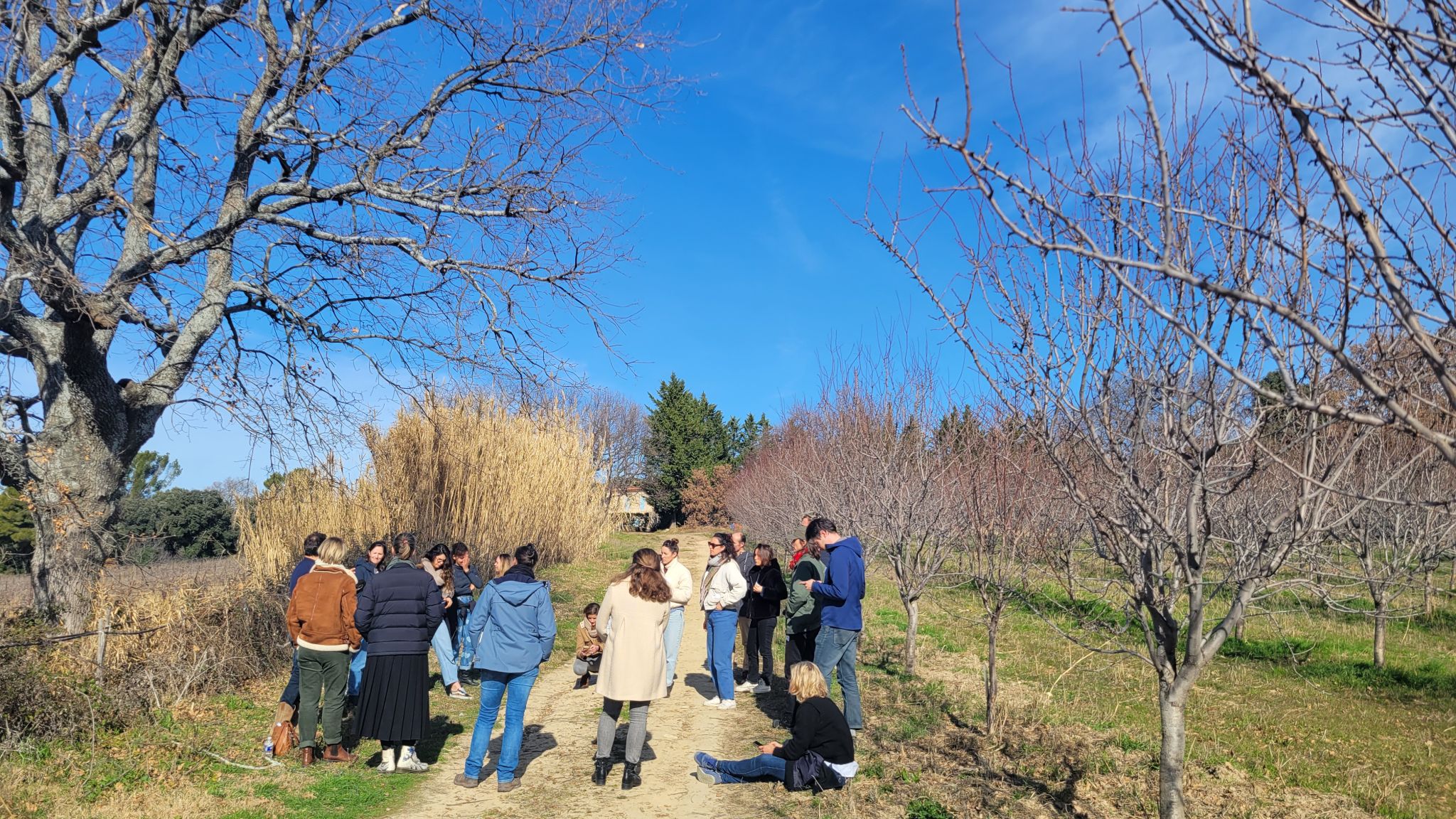Field visit series: Amandera

Early February, Rémy Frissant, Amandera's COO, welcomed us for a day on his orchards.
The event gathered a group of 25 people with completely different experiences and backgrounds:
FARMERS - INVESTORS - EXPERTS - BRANDS - DISTRIBUTORS
The first objective of that field trip was to align and deepen their understanding of the fundamental roadblocks to transition: agronomic, economic and social. And design appropriate solutions to address them.
Land regeneration, at scale
This is what Rémy FRISSANT has proven with his almond orchards: it's possible to produce large quantities while regenerating ecosystems.
In a few years, he has restored soils damaged by years of intensive monoculture. And the yields are there!
By applying a few key principles:
1️⃣ Feed the soil to nourish the trees
- Sowing cover crops between rows (from the time the trees are planted)
- Adding homemade compost at the base of the trees
- Using sheeps to fertilize and mow (naturally 🙃)
- ✅ More fertility, more life in the soil: from about a dozen to 300 earthworms per m2.
2️⃣ Diversifying crops
- Planting trees and sowing a more complex cover crop between rows
- Sowing legumes in the row
- ✅ Carbon storage. A niche and cover for biodiversity.
3️⃣ Regenerative hydrology
- Planting trees in a “keyline” design
- Focused work on grassing
- Constructing ponds
- ✅ Slowing down water in the territory, so it infiltrates and is stored
With its share of failures, fears, and lessons: 🐭 Faced with the arrival of voles that love mulch, Rémy refuses to use the recommended poisons. By letting nature take its course, predators arrive. Result: only 0.01% losses in the orchards. 🐗 The wild boars have taught Rémy the lesson not to plant his hedges in the fall.
Beyond technical matters:
Economic and social roadblocks
🌱 During the visit, Rémy FRISSANT underscored that the journey to regeneration extends far beyond mere technical hurdles, delving into economic and sociological territories.
💰 Economic roadblocks
We very often hear about the need for a market, a premium to recognize the value added by farmers regenerating the lands. It implies engaging the whole ecosystem in supporting farmers: consumers, brands, distributors. And that's totally true. However we rarely talk about the true cost of regeneration.
Under the lobbying of large food corporations, regenerative practices are increasingly becoming synonymous with fundational agroecological practices, such as reduced tillage, cover cropping, or diversifying crop rotations. Remarkably, adopting such basic measures can start from as low as $100 per hectare.
🌿💸 Yet, genuine regeneration demands a deeper commitment, with costs potentially soaring to $5,000 per hectare, depending on the desired speed and scope of implementation.
🌍❤️ True regeneration is about reinstating the balance of living ecosystems, harmonizing with nature, and employing principles tailored to the specific context rather than a fixed set of practices. This holistic approach challenges us to rethink our relationship with the land, advocating for a sustainable harmony that respects both our agricultural ambitions and the intricate web of life sustaining our planet.
🚜💵 That's why if we want to massively regenerate our ecosystems within a timeframe compatible with the planetary limits, instead of ticking marketing checkboxes imposed by the food industry, we need adequate funding going to the farmers.
Social aspects
The social and anthropological dimensions of agricultural transition are frequently overlooked, yet they arguably represent the most significant barriers to generating widespread impact. The shift towards regenerative agriculture isn't just a farming practice change; it's a profound transformation that challenges deep-seated community ties and identities.
When a farmer opts for the regenerative path, they're confronted with two pivotal changes:
- 👋🏽🚶♂️ The necessity to step away from the conventional community, risking isolation.
- 🌾🛑 Their conventional farming neighbors might view this choice as a direct challenge or critique of their lifelong practices. Many are caught in a relentless cycle of chemical dependency, the pursuit of higher yields, expanding their farming acreage, and grappling with substantial debt. Far from feeling encouraged, these farmers may adopt a defensive stance, eager to highlight any minor setback in the regenerative farmer's efforts.
🏅🌱 For regenerative agriculture to become the most appealing option, it must offer more than just environmental benefits.
🌟💪 It needs to promise economic viability, ensuring farmers that their shift will not only sustain but potentially enhance their livelihood.
🌏👏 Social acknowledgment of their role in fostering a healthier planet, beyond merely producing food, is crucial. Public authorities and society at large must champion regenerative farming as the norm, not the exception, highlighting its critical contribution to environmental sustainability and community well-being.
This approach can transform defiance into inspiration, making regenerative agriculture a collective endeavor towards a more sustainable future 🌈🌾.